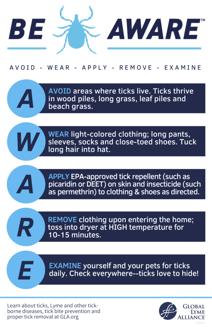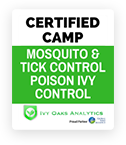Tick Awareness & Prevention Education: Be Tick AWARE
Tick Prevention

Tick bite prevention is a critical first step to prevent Lyme disease and/or other tick-borne illnesses. Each year, ticks are becoming more active beyond tick season (spring to late summer/fall). They are also expanding their geographical footprint. Lyme disease cases are increasing. You can be bitten by a tick in your own backyard.
Join GLA to #BeTickAWARE™! To raise Lyme disease awareness and protect yourself, family, and pets from ticks.
Be Tick AWARE
Be proactive - practice effective tick bite prevention habits to prevent Lyme disease and other tick-borne illnesses. Make these habits a part of your daily routine.
Tick Prevention: 5 Easy Steps to Prevent a Tick Bite
- AVOID areas where ticks live. Ticks thrive in places like wood piles, leaf litter, long grass, beach grass, bushy areas, stone walls, and perimeters where the lawn meets the woods.
- WEAR light-colored clothing to spot ticks more easily; long-sleeved shirt tucked in at the waist, long pants tucked into high socks, closed-toe shoes, and a hat with your hair tucked in, if possible. Do not walk in the grass barefoot or in open sandals, even if it’s a shortcut.
- APPLY EPA-approved tick repellent (such as picaridin or DEET) to skin and insecticide (such as permethrin) to clothing, and shoes as directed. Watch video to learn how to properly apply repellent.
- REMOVE clothing upon entering the home; toss into the dryer at high temperature for 10-15 minutes to kill live ticks. Putting them in the washer, however, will not.
- EXAMINE yourself and your pets for ticks daily. Feel for bumps paying close attention to the back of knees, groin, armpits, in and behind the ears, belly button, and scalp. Check everywhere – ticks love to hide where the sun don't shine.
Stay Connected, Make an Impact
Join our community of advocates by subscribing to our newsletter—stay informed with the latest breakthroughs in Lyme disease research and news. Ready to take the next step? Your donation to Global Lyme Alliance fuels the fight for a cure.
Subscribe Now to stay involved, or Donate Today to help us overcome Lyme disease.
How to Remove a Tick: What to Do If You Find One Attached
As hard as it may seem, don’t panic. Follow these steps to to remove an attached tick. Click here to print the instructions.
STEP 1. Remove the tick
Remove the tick with a tick removal tool or tweezers. Get as close to the skin as possible, being careful to get the head – pull the tick straight up – immediately clean the site of the bite with and antiseptic or soap.
👍 DO! Save the tick in a sealable bag or vial with date of removal 👎 DO NOT! Twist or agitate the tick - Touch the tick - "Drown" the tick
in oil or petroleum jelly to remove, it could spread any pathogens
Watch tick removal video.
STEP 2. Get your tick tested
Testing the tick is important to identify its species and diseases it may be carrying. This information can aid in your diagnosis. It will also help researchers learn more about tick habitats and patterns. Ask the lab to test the tick for Lyme disease and other tick-borne pathogens. Request that your lab test for Lyme disease and other tick-borne pathogens (co-infections).
See list of tick testing labs.
Additionally, take a photo of the tick before and after you remove it, and submit the photos to the TickSpotters program for rapid species identification. Simply add a clear top side view of your tick and complete the form questions. You can include optional info in the description line if you want to.
STEP 3. Monitor your bite site closely
- In addition to a photo of the tick, take a picture of the site of the bite as soon as possible. If you see any changes, take additional pictures. This is helpful to share with your doctor.
- Draw a circle around the bite to easily track a rash that may start from the bite. Watch the site and other parts of your body to see if a rash develops for about a week or more. Any changes can mean a reaction to a pathogen from a tick.
- Keep a close eye on your bite site and document any changes.
It’s important to note that while the bulls-eye rash is most associated with Lyme disease, many people do not develop a rash or the appearance of the rash may not be a bulls-eye. If you do develop a bulls-eye, CDC guidelines indicate this as a positive diagnosis for Lyme disease, and treatment should be started immediately.
STEP 4. Consult with your doctor
AS SOON AS YOU EXPERIENCE ANY SYMPTOMS, see a doctor. A symptom could be a reaction at the bite site or other form of rash, fatigue, brain fog, or flu-like symptoms. Note: a bulls-eye rash serves as an official Lyme disease diagnosis per the CDC. At the first signs of symptoms, 21 days of an antibiotic treatment (doxycycline or others) are recommended immediately. Early diagnosis and treatment are key!
It’s important to note that while the bulls-eye rash is most associated with Lyme disease, many patients do not develop a rash or the appearance of the rash is not a bulls-eye.
Step 5. Trust your symptoms, not the test
Current Lyme diagnostics are inaccurate about 1/2 the time! It’s important to remember that if your doctor says your test came back negative, but you are feeling symptomatic, you may still have Lyme disease. Trust your symptoms, not the test!
If you need help connecting with a Lyme treating physician, GLA can help.
Tick Prevention Resources
Help us share the message of tick bite prevention! Please use and share our Be Tick AWARE resources with your communities, libraries, schools, and social networks.
VIDEOS
How to Be Tick AWARE
How to Properly Apply Repellent
INFORMATION SHEETS
Check 4 Ticks (people) poster
Check 4 Ticks (dogs) poster
Be Tick AWARE poster
How to Identify Ticks
5 Steps: What to Do When You Find a Tick Attached
FLYERS
Be Tick AWARE awareness flyer to share
Be the Change in the Fight Against Lyme Disease
Lyme disease is relentless, but so are we. Your donation powers the research that leads to breakthroughs and patient service programs that prevents suffering. Stand with us in the fight—your contribution can create lasting change and future relief for so many.
Donate Today and Be a Part of the Solution.




